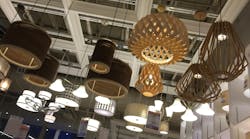All references are based on the 2017 edition of the NEC, unless otherwise noted.
Sometimes a very good Code change can produce some unintended consequences. Here’s a prime example.
Section 230.29 was revised during the last Code cycle to require bonding of metal support structures that are installed to support overhead service conductors passing over roofs. For grounded systems, these metal support structures are now required to be bonded to the grounded overhead service conductor. Bonding these support structures — or “roof jacks” as they are sometimes called — is required to minimize the possibility of them becoming energized and creating a shock hazard due to damaged conductors. Because services don’t usually contain equipment grounding conductors (EGCs), these metal roof jacks must be bonded to the grounded conductor to create an effective ground-fault current path in accordance with Sec. 250.4(A)(4). The bonding jumper would be sized in accordance with Sec. 250.102(C)(1) based on the size of the ungrounded service conductors. This new requirement sounds like a terrific idea to me. It’s a great way to reduce shock hazards. Unfortunately, this rule also has some questionable unintended consequences. In this case, the changes in Sec. 230.29 create problems in another Code section where there weren’t any changes made.
Outside feeders and branch circuits that are installed as overhead conductors above buildings must comply with Sec. 225.15. This section states that supports over a building must comply with Sec. 230.29. Thus, the problems begin.
Outside branch circuits and feeders could contain ungrounded conductors, grounded conductors, and EGCs. Where these circuits are installed on roof jacks to support them above a roof, Sec. 230.29 would now require the metal roof jack to be bonded to the grounded conductor. Yes, that’s correct. The wording in the Code literally requires you to bond the roof jack to the grounded conductor instead of the EGC of the overhead feeder or branch circuit. I certainly don’t think that was the intent of this change.
In the case of overhead feeders or branch circuits, the metal roof jacks should be bonded to the EGC of the circuit instead of the grounded conductor. Why would you bond to the grounded conductor when there is a perfectly good EGC to use? In fact, bonding the roof jack to the grounded conductor of a feeder or branch circuit would create a violation of Sec. 250.142(B).
So the next time you’re installing a metal roof jack, you might want to have a discussion with your AHJ about the best way to bond it.





